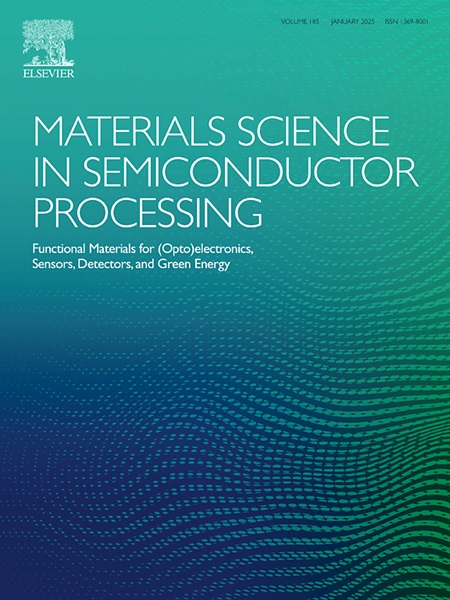预测InN-HfXO (X=S, Se)范德华异质结构的光学和热电性质
IF 4.6
3区 工程技术
Q2 ENGINEERING, ELECTRICAL & ELECTRONIC
引用次数: 0
摘要
垂直堆叠范德华异质结构(vdWHs)因其作为热电材料的潜力而受到广泛关注。在这项研究中,我们采用第一性原理计算来探索皱褶InN-HfXO (X=S, Se) vdWHs的结构稳定性、光学特性和TE特性。利用弹性常数、声子色散和从头算分子动力学模拟综合证实了vdWHs的力学、动力学和热稳定性。利用结合光子电子相互作用的Bethe-Salpeter方程,我们发现两种vdWHs在可见光谱中都具有明显的吸收峰,具有光学活性。我们的研究揭示了300 K时高载流子迁移率和低热导率,这归因于较少的散射事件和增强的声子色散。基于玻尔兹曼输运理论,在800 K时预测的InN-HfSO(1.437)和InN-HfSeO(2.303)的高品质系数(ZT)值表明,这些材料可以有效地用于高温下的能量转换应用。这些发现为二维(2D)层状异质结构作为具有量子级优势的高效TE材料提供了一种战略设计方法。本文章由计算机程序翻译,如有差异,请以英文原文为准。

Predicting optical and thermoelectric properties of InN-HfXO (X=S, Se) van der Waals heterostructures
Vertically stacked van der Waals heterostructures (vdWHs) have garnered attention owing to their potential as thermoelectric (TE) materials. In this study, we employed first-principles calculations to explore the structural stability, optical, and TE properties of wrinkled InN-HfXO (X=S, Se) vdWHs. The elastic constants, phonon dispersion, and molecular dynamics simulations are used to synthetically confirm the mechanical, dynamical, and thermal stabilities of the vdWHs. Using the Bethe–Salpeter equation incorporating photon–electron interactions, we found that both vdWHs exhibited optical activity with a prominent absorption peak in the visible spectrum. Our study reveals high carrier mobility and low thermal conductivity at 300 K, which is attributed to fewer scattering events and enhanced phonon dispersion. Based on Boltzmann transport theory, the predicted high figure of merit (ZT) values for InN-HfSO (1.437) and InN-HfSeO (2.303) at 800 K suggest that these materials could be effective for energy conversion applications at elevated temperatures. These findings offer a strategic design approach for two-dimensional (2D) layered heterostructures as efficient TE materials with quantum-level advantages.
求助全文
通过发布文献求助,成功后即可免费获取论文全文。
去求助
来源期刊

Materials Science in Semiconductor Processing
工程技术-材料科学:综合
CiteScore
8.00
自引率
4.90%
发文量
780
审稿时长
42 days
期刊介绍:
Materials Science in Semiconductor Processing provides a unique forum for the discussion of novel processing, applications and theoretical studies of functional materials and devices for (opto)electronics, sensors, detectors, biotechnology and green energy.
Each issue will aim to provide a snapshot of current insights, new achievements, breakthroughs and future trends in such diverse fields as microelectronics, energy conversion and storage, communications, biotechnology, (photo)catalysis, nano- and thin-film technology, hybrid and composite materials, chemical processing, vapor-phase deposition, device fabrication, and modelling, which are the backbone of advanced semiconductor processing and applications.
Coverage will include: advanced lithography for submicron devices; etching and related topics; ion implantation; damage evolution and related issues; plasma and thermal CVD; rapid thermal processing; advanced metallization and interconnect schemes; thin dielectric layers, oxidation; sol-gel processing; chemical bath and (electro)chemical deposition; compound semiconductor processing; new non-oxide materials and their applications; (macro)molecular and hybrid materials; molecular dynamics, ab-initio methods, Monte Carlo, etc.; new materials and processes for discrete and integrated circuits; magnetic materials and spintronics; heterostructures and quantum devices; engineering of the electrical and optical properties of semiconductors; crystal growth mechanisms; reliability, defect density, intrinsic impurities and defects.
 求助内容:
求助内容: 应助结果提醒方式:
应助结果提醒方式:


